Solved Questions on Triangles
1. In the given quadrilateral PQRS, PQ = PR = PS, PR bisects ∠QRS and ∠RPS = 72°. What is the value of q?
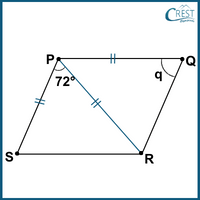
a) 44°
b) 54°
c) 64°
d) 74°
Answer: b) 54°
Explanation: In the given quadrilateral PQRS,
PQ = PR = PS
PR bisects ∠QRS. Therefore, ∠PRQ = ∠PRS
∠RPS = 72°
In △PSR,
∠PRS + ∠PSR + ∠RPS = 180° (Angle Sum Property of a Triangle)
∠PRS + ∠PRS + 72° = 180° (PR = PS, ∠PSR = ∠PRS)
2∠PRS = 180° − 72°
2∠PRS = 108°
∠PRS = 54°
In △PQR,
∠PRQ = ∠PRS = 54° (PR bisects ∠ QRS)
q = ∠PRQ = 54° (PQ = PR)
2. Which of the following options expresses x in terms of y?
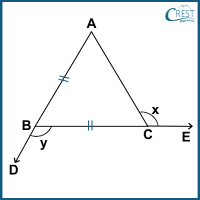
a) x = 180° +
b) x = 180° −
c) x = 180° + 2y
d) x = 180° − 2y
Answer: b) x = 180° −
Explanation: ∠ACB + ∠ACE = 180° [Linear Pair]
∠ACB + x = 180°
∠ACB = 180° − x
∠BAC = ∠ACB = 180° − x (Angle opposite to equal sides are equal, AB = BC)
∠ABC + ∠CBD = 180° [Linear Pair]
∠ABC + y = 180°
∠ABC = 180° − y
In △ABC,
∠ACB + ∠BAC + ∠ABC = 180° (Angle Sum Property of a Triangle)
180° − x + 180° − x + 180° − y = 180°
540° − 2x − y = 180°
2x + y = 540° − 180°
2x + y = 360°
2x = 360° − y
x =
x = 360°⁄2 − y⁄2
x = 180° − y⁄2
3. What is the length of PR using the information given in the figure?
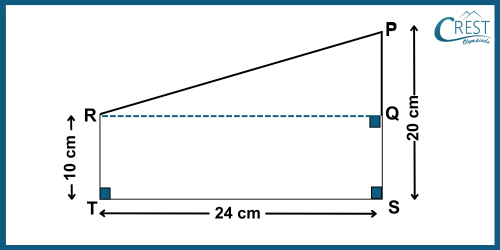
a) 22 cm
b) 24 cm
c) 26 cm
d) 28 cm
Answer: c) 26 cm
Explanation: In △PQR,
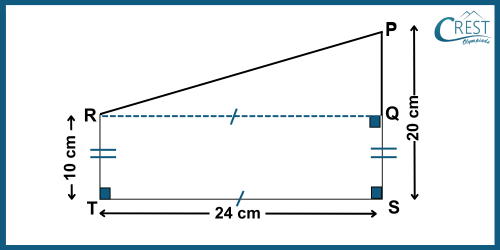
RQ = TS = 24 cm
PQ = PS − QS = PS − RT = 20 − 10 = 10 cm
PR2 = OD2 + OA2 [Pythagoras’ Theorem]
PR = √(RQ2 + PQ2)
PR = √(242 + 102)
PR = √(576 + 100)
PR = √676
PR = √(26 × 26)
PR = 26 cm
4. In △XYZ, OZ bisects ∠Z and ∠OXZ = ∠OYZ. Which of the following is true?
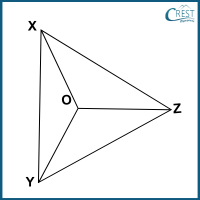
a) ∠XOZ = ∠YOZ; OX = OY; XY = YZ
b) ∠XOZ = ∠YZO; OX = OY; XZ = YZ
c) ∠XOZ = ∠YOZ; OX = OZ; XZ = YZ
d) ∠XOZ = ∠YOZ; OX = OY; XZ = YZ
Answer: d) ∠XOZ = ∠YOZ; OX = OY; XZ = YZ
Explanation: In △XOZ and △YOZ,
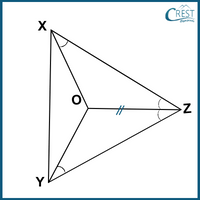
∠OXZ = ∠OYZ (Given)
OZ = OZ (Common)
∠OZX = ∠OZY (OZ bisects ∠Z)
△XOZ ≅ △YOZ (A.S.A)
OX = OY (Corresponding Parts of Congruent Triangles are Equal)
XZ = YZ (Corresponding Parts of Congruent Triangles are Equal)
∠XOZ = ∠YOZ (Corresponding Parts of Congruent Triangles are Equal)
5. The ratio between a base angle and the vertical angle of an isosceles triangle is 1 : 2. What is the value of each angle of the triangle?
a) Base Angle = 75° and Vertical Angle = 30°
b) Base Angle = 60° and Vertical Angle = 60°
c) Base Angle = 45° and Vertical Angle = 90°
d) Base Angle = 30° and Vertical Angle = 120°
Answer: c) Base Angle = 45° and Vertical Angle = 90°
Explanation: In △ABC,
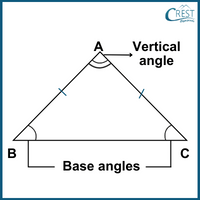
Base Angle : Vertical Angle =1 : 2
Let each base angle be x° and vertical angle be 2x°.
∠ABC = ∠ACB = x° (Base Angles)
∠CAB = 2x° (Vertical Angle)
∠ABC + ∠ACB + ∠CAB = 180° (Angle Sum Property of a Triangle)
x° + x° + 2x° = 180°
4x° = 180°
x° =
x° = 45°
Each Base Angle = ∠ABC = ∠ACB = x° = 45°
Vertical Angle = ∠CAB = 2x° = 2 × 45° = 90°








